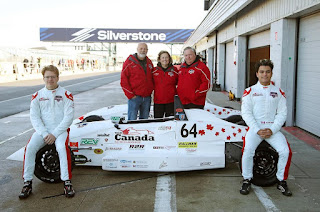Competing Across Continents: The Role of Team USA Scholarship in Young Drivers’ Success
International travel is pivotal to the world of motorsport, with annual races and events taking place around the globe. The importance of travel is not exclusive to the highest levels of the sport however, with countless young drivers often travelling extensive distances to advance their careers. For young competitors harbouring dreams of a future in motorsport (especially Formula One), it is widely accepted that Europe, particularly the UK, is the optimal destination. Each year, numerous aspiring drivers travel to compete against some of the highest calibre competitors in the world- however there are difficulties involved in this process that often go undiscussed.
These young drivers face a comparative disadvantage in terms of experience before they even step on track, competing in championships against others who have often been racing in familiar conditions far longer. This lack of comparative experience, paired with potential language/ cultural barriers, home-sickness, and the young age at which these racers travel and have to develop independence culminates in a very difficult journey to high-level racing, without even mentioning the potential lack of support system and financial difficulties often faced. It is for these reasons, and more, that programs providing support to young drivers are so vital.
These young drivers face a comparative disadvantage in terms of experience before they even step on track, competing in championships against others who have often been racing in familiar conditions far longer. This lack of comparative experience, paired with potential language/ cultural barriers, home-sickness, and the young age at which these racers travel and have to develop independence culminates in a very difficult journey to high-level racing, without even mentioning the potential lack of support system and financial difficulties often faced. It is for these reasons, and more, that programs providing support to young drivers are so vital.
One such program is the Team USA Scholarship- founded in 1990, when opportunities for young American drivers were uncommon, with the intention to give some of the USA’s rising talents in motorsport the opportunity to race against some top-level competitors in international racing events.
Each year, the program sends two drivers to race in the UK, in both the Formula Ford Festival at Brands Hatch and the Walter Hayes Trophy at Silverstone. This not only gives these young drivers the opportunity to learn and develop their skills, but also present these skills to an international audience, develop their media capabilities and help them form connections that could facilitate their future success.Whilst attending the Walter Hayes Trophy earlier this month, I was fortunate enough to talk with the Team USA drivers, Jack Sullivan and Ayrton Houk, discussing topics such as their experiences with the program, how they have found racing in the UK and their future ambitions moving forward from the scholarship.
Jack began racing at age five, staying in vintage karting until 2018. He then moved into modern karts, graduating to the X30 category before making the move into cars with the Lucas Oil School of Racing in 2020. In 2021, Jack and his father purchased a Piper F1600 car and he began to compete in various SCCA events, winning a Major Tour event and a regional title. Following on from this, in 2022 he ran a partial season in the F1600 Championship Series, then went on to finish third in the 2023 season before coming over to the UK with Team USA.
Ayrton began his racing journey in off-road motorcycles at age 4, continuing this for 9 years until he made the transition into go-karts at age 12. After around 4 years of karting, he branched out into both on-road courses, in F1600, and on ovals in the Kenyon Midget Series. In 2021, he won both the Lucas Oil School Racing Scholarship and the Kenyon Midget Series, then finished second in the F1600 Championship in both 2022 and 2023, before travelling to compete with Team USA in the UK.
The two drivers involved in the Team USA Scholarship each year are given the unique opportunity to experience UK tracks, racing and conditions, providing “an incredible platform for development”. It is clear that there are key differences between racing in the UK and US, with Ayrton first highlighting the high calibre of drivers comparative to those in the US, discussing that “in the US as a general trend, you’ll have around 6 or 7 people up front, competing for a win, and then the rest aren’t as competitive”, whereas “over here, the entire field is right on pace, the margins from first to last are much smaller, so it exaggerates any mistake that you make”. He made it clear that this exposure to competitors who have this unfamiliar, “much tighter, much more aggressive” driving style has been hugely beneficial, making him more conscious of where he is in relation to others, the actions being taken by those around him and how he can react to these factors, therefore evolving his own abilities and making him “a much better driver as a result”. Jack echoed this, adding that they have both been forced to adapt and evolve to keep up with these competitive fields, especially due to “the race lengths being shorter”. This has meant that both drivers have had to become accustomed to getting the most of the car from the very beginning of each race and pushing to the best of their abilities because “you can’t really take a lap or two to warm-up like you can in the American races, where you have a little more time to get into a rhythm or recover from mistakes in order to deliver the best results, you have to be on it from the start”.
It is evident that the Team USA Scholarship provides a great opportunity for drivers to learn and develop their skills, however it is also vital that these drivers find a balance between learning from their competitors to enhance their own skills, whilst simultaneously remaining competitive and battling them on track. Jack discussed that in order to be competitive in these fields, a lot of learning came before they even got on track. “A lot of learning in the initial stages came from some of the drivers who have taken part in the Team USA Scholarship before us, learning from them and analysing their video and data from past years has been super helpful”. Ayrton emphasised this, describing how “things like looking over data with the team and having Elliott (Budzinski) help to coach us, who has been in the car all year and is also from the US. He has a very good way of explaining the differences because he’s driven in both situations, so he’s been able to verbalise what is going on in the car really well, which has played a massive role for me and Jack in our development whilst we’ve been here”. On top of this, both Jack and Ayrton also expressed how vital it has been to try to learn from their competitors, “the largest part of learning over here has just been getting on track with a lot of these drivers, who have been in the car far longer than we have”, “getting behind other people and seeing things like how they manoeuvre the car and how much further they push into the corner has really helped- you really have to get behind the quick drivers and stay with them”.
It isn’t purely on-track skills developed by the Team USA Scholarship however, with one major additional aspect being media work. Throughout their time in the UK, both drivers have “typically been getting one interview every weekend due to the scholarship”, their races have been live-streamed, and the drivers have been providing regular social media updates regarding their activities. Jack described how this has been vastly different to the US, as “in America, there’s not really any publicity as far as media goes, you won’t usually have at-track livestreams, or any sort of interviewing”. Therefore, the Team USA Scholarship has been extremely valuable, providing the drivers with media experience that they would not otherwise have, giving them an advantage moving forward in their careers. Ayrton confirmed this, emphasising how “media is massive part of racing today that people tend to overlook”. It is evident that this media experience will be invaluable, as “sponsors like to see someone who is marketable and is able to promote their brand well, so being good on the media side is definitely a necessary attribute when you want to progress up the ranks”. He stated that “the amount of media experience that we’re getting here will definitely play a massive part in our development, all the way through to our careers”, summarising the evident benefit that both drivers have received from the program.
Moving forward, both Team USA Scholarship drivers have clearly developed ambitions for the future. Ayrton expressed his current aspiration to move into the USF2000 Championship, detailing how his experience in the UK has aided his progression toward this goal, “this car, just the driving style, has already trained me massively to be able to make the jump comfortably, as I move into a faster, higher horsepower, higher downforce type of car”. Alternatively, Jack spoke a little bit about his interest in racing in the UK in future- detailing how the experience of testing a GB3 car whilst in the UK with Ammonite Motorsport “solidified my goal to eventually run something over here, whether that be in the GB3 or GB4 series”. Both drivers gave special mention to the “media experience, new connections and network expansion” that they have gained as a result of the program, expressing how “it will be easier to find sponsors and partners that facilitate our goals, compared to how much more difficult it would be without the resources and help from Team USA Scholarship”.
(All photos by Sophie Lewis/ @sophielewisphotography)




Comments
Post a Comment